| |
Magellan
meets the Giants or the CROSS Unmasked at Last!! |
|
| 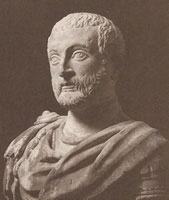
Antonio
Pigafetta (c.1491-1534). |
Venetian
Antonio Pigafetta was one of only 17 survivors who sailed around
the world on the Magellan 5 ship expedition of 1519. |
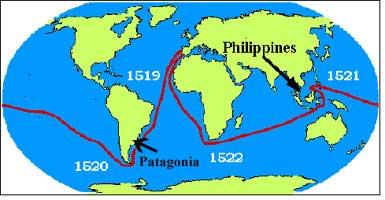
Around
the world with Antonio Pigafetta.
|
Antonio
Pigafetta —a Venetian nobleman— joined the expedition
of Magellan as the official chronicler of the voyage. Pigafetta kept
a richly detailed diary of the expedition in which he made entries
every day of the entire odyssey. Pigafetta said that one of the reasons
for joining the expedition was to gain some fame for posterity:
"Antonio
Pigafeta, patrician of Venezia and knight of Rhodi [i.e., Rhodes],
to the most illustrious and excellent Lord, Philipo de Villers Lisleadam,
renowned grand master of Rhoddi, his most honored lord .
. . and having learned many things from many books that I had read,
as well as from various persons, who discussed the great and marvelous
things of the Ocean with his Lordship, I determined by the good
favor of his Caesarean Majesty, and of his Lordship abovesaid, to
experience and to go to see those things for myself, so that I might
be able thereby to satisfy myself somewhat, and
so that I might be able to gain some renown for later posterity.
Having heard that a fleet composed of five vessels had been fitted
out in the city of Siviglia for the purpose of going to discover
the spicery in the islands of Maluco, under command of Captain-general
Fernando de Magaglianes, a Portuguese gentleman, comendador of the
[Order of] Santo Jacobo de la Spada [i.e., "St. James of the
Sword"
(Diary of Pigafetta, p. 23.)
Unlike
most of the crew, Pigafetta was of one mind with Magellan and almost
died defending Magellan at the Battle of Mactan. Pigafetta was one
of only 17 survivors whose ship, The Victoria, arrived back
safely in Spain on September 8, 1522.
His
diary or journal was subsequently published in Italian, French, Spanish
and later translated into English.
Magellan
meets the Patagonian giants!!
Magellan
carefully followed John Cabot's maps down the coast of Brazil to the
country we call Argentina today. While he was wintering in a harbor
he had his first encounter with the Patagonian giants. Encountering
these giants was like a trip back in time thousands of years to the
days of the Tower of Babel. Here is an excerpt from the diary of Pigafetta:
"Leaving
that place, we finally reached 49 and one-half degrees toward the
Antarctic Pole. As it was winter, the ships entered a safe port
to winter. We passed two months in that place without seeing anyone.
One day we suddenly saw a naked man of giant stature on the shore
of the port, dancing, singing, and throwing dust on his head. The
captain general sent one of our men to the giant so that he might
perform the same actions as a sign of peace. Having done that, the
man led the giant to an islet into the presence of the captain-general.
When the giant was in the captain-general's and our presence, he
marveled greatly, and made signs with one finger raised upward,
believing that we had come from the sky. He
was so tall that we reached only to his waist, and he was well proportioned.
His face was large and painted red all over, while about his eyes
he was painted yellow; and he had two hearts painted on the middle
of his cheeks. His scanty hair was painted white. He was dressed
in the skins of animals skillfully sewn together. That animal has
a head and ears as large as those of a mule, a neck and body like
those of a camel, the legs of a deer, and the tail of a horse, like
which it neighs, and that land has very many of them. His feet were
shod with the same kind of skins which covered his feet in the manner
of shoes. In his hand he carried a short, heavy bow, with a cord
somewhat thicker than those of the lute, and made from the intestines
of the same animal, and a bundle of rather short cane arrows feathered
like ours, and with points of white and black flint stones in the
manner of Turkish arrows, instead of iron. Those points were fashioned
by means of another stone."
(Diary of Pigafetta, pp. 51-52).
The
giant introduced Magellan to the demon god Setebos
A
demon god named Setebos ruled the giants. The light of true Christianity
had never shone on that dark place so the demons needed no disguise:
"When
one of those people die, ten or twelve demons all painted appear to
them and dance very joyfully about the corpse. They notice that one
of those demons is much taller than the others, and he cries out and
rejoices more. They paint themselves exactly in the same manner as
the demon appears to them painted. They call
the larger demon Setebos, and the others Cheleulle. That giant also
told us by signs that he had seen the demons with two horns on their
heads, and long hair which hung to the feet belching forth fire from
mouth and buttocks. The captain-general called those people
Patagoni (bigfeet). They all clothe themselves in the skins of that
animal above mentioned; and they have no houses except those made
from the skin of the same animal, and they wander hither and thither
with those houses just as the Cingani do. They live on raw flesh and
on a sweet root which they call chapae. Each of the two whom
we captured ate a basketful of biscuit, and drank one-half pailful
of water at a gulp. They also ate rats without skinning them."
(Diary of Pigafetta, p. 61).
The
CROSS was the symbol for Setebos!!
Magellan
was very anxious to convert the giant to Roman Catholicism and here
is the giant's reaction when he saw the CROSS:
"Once
I (Pigafetta) made the sign of the cross, and, showing it (the cross)
to him, kissed it. He immediately cried out " Setebos,"
and made me a sign that if I made the sign of the cross again, Setebos
would enter into my body and cause it to burst. When that giant was
sick, he asked for the cross, and embracing it and kissing it many
times, desired to become a "Christian" before his death.
We called him Paulo."
(Diary of Pigafetta, p. 83
The
seducing demons in Magellan and his crew convinced the giant that
the CROSS was CHRISTIAN and that he had nothing to fear from Setebos
by embracing it. He took the bait and died shortly thereafter—
another victim of Rome's seducing spirits and doctrines of
devils.
Magellan
tried to get Philippine chief to worship the CROSS!!
Cross
worship was rampant in Europe before the blessed Reformation. Wherever
Magellan went he set up the infernal CROSS idol and tried to get
the native people to worship it. One chief refused to worship this
image of the beast, and as a result, Magellan declared war on him
and his tribe. This brave chief's name was Lapulapu:
Magellan
set up a cross on the highest point in the island and commanded
ALL to worship it:
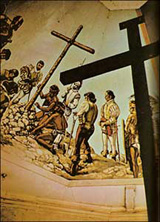
Painting
on the ceiling of a church in Cebu in the Philippines depicting
Magellan planting a cross.
|
Magellan
set up a cross idol on the highest point in the island and
commanded ALL to fall down and worship it!! |
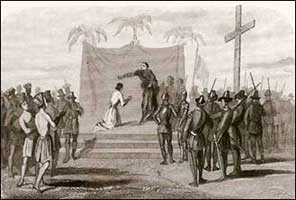
Magellan
forced the Philipinos to worship his cross idol telling
them that it was "Christianity."
|
Here
is a quote from the diary of Antonio Pigafetta:
"After
dinner they all returned wearing their actons, and with the two
kings they went to the middle of the summit of the highest mountain
on the island, and set up the CROSS.
And the Captain told them that they were true friends to them, because
the CROSS was there, and that they
could greatly rejoice therefore. And he asked them which was the
best port for revictualing. They replied that there were three of
them. Ceylon (Leyte), Zubu (Cebu), and Calaghan (the district of
Caraca on Mindanao), but that Zubu was the largest and had the most
trade. And they offered to give them pilots who would show them
the correct route. The Captain General thanked them, and decided
to go there, as his unhappy fate would have it. When the CROSS
was set up everyone said a Pater Noster, and an Ave Maria, and
they worshipped it. And the kings did likewise. Afterwards
they went down into the cultivated fields" (Diary of Pigafetta,
p. 46).
Charles
Darwin was another faker who denied the existence of giants!!
Charles Darwin was another faker who sailed around the world and
kept a detailed diary. When he arrived in the area of Patagonia
he lied and denied that GIANTS actually existed.
Where
ignorance is bliss, 'tis folly to be wise; because Darwin knew that
the existence of GIANTS would confirm the Bible and destroy his
entire theory of EVILution.
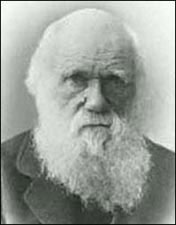
Charles
Darwin (1809-1882).
|
|
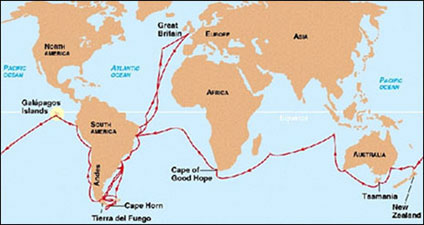
Darwin
kept a detailed diary of his trip around the world from 1831
to 1836.
|
Here
is an except from The Voyage of the Beagle, chapter XI:
"During
our previous visit (in January), we had an interview at Cape Gregory
with the famous so-called gigantic Patagonians, who gave us a cordial
reception. Their height appears greater than it
really is, from their large guanaco mantles, their long flowing hair,
and general figure: on an average, their height is about six feet, with
some men taller and only a few shorter; and the women are also tall;
altogether they are certainly the tallest race which we anywhere saw.
In features they strikingly resemble the more northern Indians whom
I saw with Rosas, but they have a wilder and more formidable appearance:
their faces were much painted with red and black, and one man was ringed
and dotted with white like a Fuegian."
(Darwin, The Voyage of the Beagle, pp. 206-207).
Darwin
claimed to have found the "missing link" in Patagonia!!
Modern
evilution was born when Darwin arrived in Tierra del Fuego in present
day Argentina. When he saw the natives with their primitive ways,
his demon possessed "brain" conceived the idea that they
were sub-human or a link with his APE ancestors.
British
missionaries who tried to win the tribes to Christ, and lift them
from the degradation that demon worship had reduced them, found the
exact opposite to be true. Here is a quote from Christian missionary
E. Lucas Bridges:
"The
belief that the Fuegians were cannibals was not the only mistake Charles
Darwin made about them. Listening to their speech, he got the impression
that they were repeating the same phrases over and over again, and
therefore came to the conclusion that something like one hundred words
would cover the whole language. We
who learned as children to speak Yahgan know that, within its own
limitations, it is infinitely richer and more expressive than English
or Spanish. My father's Yahgan or Yamana-English Dictionary,
to which I shall refer later, contains no fewer than 32,000 words
and inflections, the number of which might have been greatly increased
without departing from correct speech?
Darwin, when he saw the poverty and filth of these people, considered
that, if he had not actually found the missing link for which he sought,
these Fuegians were not far removed from it. Yet they had many social
customs that were strictly observed, and though lying and stealing
were usual, to call a man a liar, thief or murderer was a deadly insult"
(Bridges, Uttermost Part of the Earth, pp. 34-35).
|
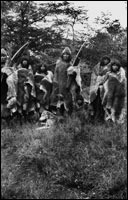
Some
Fuegian natives who were won to Christ by British missionaries. |
|
Darwin
looked down on these natives and viewed them as SUBHUMAN or
some kind of missing link between apes and men.
The British
missionaries saw them as souls for whom Jesus shed his precious
blood and they tried to win them to Christ.
They found
their language to be more complex than English or Spanish!!
The Argentineans
claimed sovereignty over their land and wiped them
out with deadly germs. |
Argentinean
Navy wipes out Fuegian natives!!
After
the British missionaries had converted the tribes to Christ and civilized
them, the Argentinean Navy—agents of the Spanish Inquisition—arrived
on the scene and wiped out most of them with bacteriological warfare.
This was to fulfill the Bull of Pope Alexander VI....This was
their land for thousands of years and they welcomed the British
missionaries. The British should have armed the natives and taught
them to use rifles in order to keep the Argentineans off their
land.
Here
is a quote from the book, Uttermost Part of the Earth:
"One
Sunday afternoon in September, 1884, sixteen years after the Mission
had begun work at Ushuaia, we were startled to see four vessels coming
up the Beagle Channel, evidently bound for our harbour. Three of them
were steamers; the fourth a sailing-cutter in tow.
Our peaceful little village was in a turmoil at once. Such a sight
had never been seen before, and the excited natives crowded round
my father and Mr. Lawrence, demanding to know what this visitation
portended. Thoughts of war and an imminent attack against our beloved
home filled some of us younger ones with fear.
The vessels continued their sinister advance, and finally dropped
anchor in the harbour. The largest of them was the transport Villarino,
the second a gunboat, the Paraná, and the third a
Government tender, the Comodoro Py—all of the Argentine
Navy.
Accompanied by Mr. Lawrence and Mr. Whaits, my father went out to
meet them in the whale-boat with a Yahgan crew. When they drew near
to the Villarino, her commander, Captain Spurr, called out
in English
" The other ship, Mr. Bridges."
He waved towards the Paraná, on boarding which Father
and his friends were most kindly welcomed by the leader of the expedition,
Colonel Augusto Lasserre. He explained to them that the object of
this visit was to establish a sub-prefecture in Ushuaia and so inaugurate
Argentine rule in the most southerly part of their domain.
When the visitors went ashore they were delighted with what they saw
there. They had spent the previous six months at Cape San Juan, on
Staten Island, erecting a lighthouse and establishing a sub-prefecture.
As Staten Island is probably the wettest and most desolate outpost
of the Fuegian archipelago, and as that winter had been unusually
severe, the cheery Mission station at Ushuaia, with the natives already
busy preparing their gardens for planting, milking their cows and
tending their calves, must have presented a striking contrast to the
dreary place they had just left.
An Argentine flag was placed in my father's hand by Colonel Lasserre.
Father lowered the flag that had flown a welcome to all comers for
so many years, and hoisted in its stead the flag of the country in
which he had made his home. There was a salvo of twenty-one guns from
the ships in the harbour; and on land the Yahgans sent up a cheer
in their own boisterous fashion.
The inaugural ceremony was attended en masse by all the Yahgans in
the neighbourhood. My father, on behalf of the Mission, promised cordial
assistance to the Argentine Government. He also spoke for the assembled
natives, expressing their allegiance to the country that had taken
them under her protection, and their desire for law and order.
In replying, Colonel Lasserre guaranteed the continued independence
of the Mission and the ready assistance of the Argentine Government,
which, he said, officially recognized the worth of the Christian and
humane work of the English missionaries.
Meanwhile at Ushuaia his worst fears were being realized.
After the departure of the Paraná and Comodoro
Py, the natives went down with this fever one after the other.
In a few days they were dying at such a rate that it was impossible
to dig graves fast enough. In outlying districts the dead were merely
put outside the wigwams or, when the other occupants had the strength,
carried or dragged to the nearest bushes.
In Stirling House and the Lawrences' home down the road all the children
were struck down at once. In the orphanage Mrs. Whaits had thirty
Yahgan children on her hands, all victims of the epidemic. My mother
and Yekadahby, neither of whom had ever heard of typhoid-pneumonia,
formed a different opinion from that of Doctors Alvarez and Fenton,
and dealt with us accordingly. Mrs. Lawrence and her sister, Miss
Martin, who had come to live with them at the settlement, agreed with
the diagnosis of Mother and Yekadahby—and so did Mrs. Whaits.
They all decided that it was measles"(Bridges, Uttermost
Part of the Earth, pp.122-124).
On
the Day of Judgment there will be a lot of secrets revealed, especially
the genocide by the Spanish against all attempts to bring true Christianity
to the New World.
Editor's
Notes
NASA—
the moonfaker people— actually named a MOON of the planet Uranus
after the demon god Setebos.
Throughout
the world, unnatural history museums are filled with giant human bones
. . . but they are all locked up tightly in the basements. They don't
mind showing you giant bones of dinosaurs but you will never
be allowed to see the bones of the Patagonians or other giant races.
Vital
link
The
Crossbusters
References
Bridges,
Lucas E. Uttermost Part of the Earth. E. P. Dutton &
Co., New York & London, 1948.
Darwin,
Charles, The Voyage of the Beagle. (Intro. by Steve Jones)
The Modern Library, New York, 2001.
Nichols
Peter. Evolution's Captain (The Dark Fate of the Man Who Sailed
Charles Darwin Around the World). HarperCollins Publishers, New
York, 2003.
Pigafetta,
Antonio. Magellan's Voyage around the World, (in 3 volumes).
Translated by James Alexander Robertson, Cleveland, 1906.
Pigafetta,
Antonio. The Voyage of Magellan. London: the Folio Society,
Yale University Press, 1969.
Pigafetta,
Antonio. The Voyage of Magellan. (Translated by Paula Spurlin
Paige), Prentice-Hall, Englewood Cliffs, New Jersey, 1969.
Copyright
© 2007 by Niall Kilkenny
Back
to Main Menu
|






